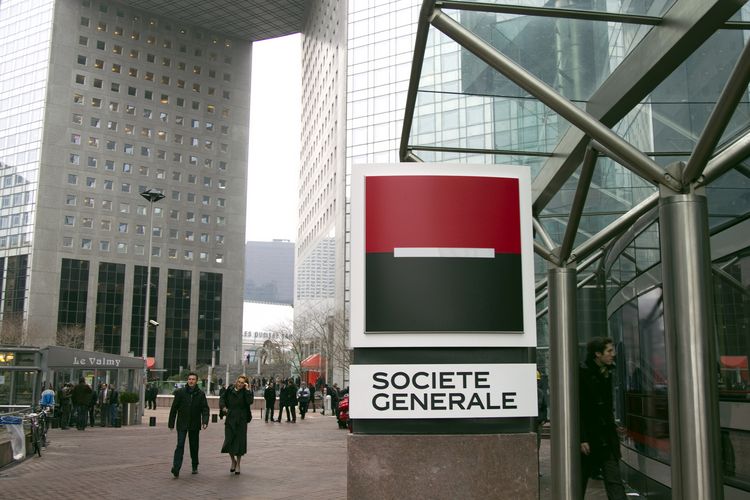The fate of European sovereigns and financial institutions has been tied ever closer together over the past 12 months, with investors questioning how banks will cope with sovereign defaults, and how sovereigns will cope with collapsing banks. In these circumstances, Societe Generale had to take funding wherever it could find it.
To view the digital version of this report, please click here.
For much of the latter part of 2011 the market for European banks was closed, embroiled in the uncertainty of the sovereign debt crisis that was ravaging Europe, but the Long Term Refinancing Operation had forced the door open early this year by satisfying investors that the European Central Bank was not about to let the banking system collapse.
Yet the uncertainty of the time defined SG’s approach to its financing activities. “We had a strategy to use every window that was available,” said Bertrand Badre, group CFO for the bank.
“We were in all the markets, for example the Dim Sum bond we issued in April was largely symbolic.”
That deal, which raised Rmb500m (US$80m) via a three-year offshore renminbi bond, made SG the first foreign bank to remit the proceeds of a Dim Sum deal onshore, with SG’s Shanghai subsidiary the ultimate beneficiary, supporting lease financing for SMEs in China. In terms of the contribution to the funding of the bank as a whole the deal is insignificant, but it demonstrates the bank’s strategy of tapping any available source, no matter how small.
“The backbone of the bank’s refinancing strategy was its covered bond deals at the start of the year,” said Badre. In January, Societe Generale Home Loan SFH completed the first covered bond deal of 2012, selling a 10-year covered bond in France that attracted €1.5bn of orders from 80 accounts. The €1.25bn deal was priced at mid-swaps plus 170bp, with ABN AMRO, BayernLB, Credit Agricole, Societe Generale itself, UBS and UniCredit working on the deal.
Ralf Grossmann, head of covered bond origination at Societe Generale, said at the time that the deal had been inspired by the successes of similar French 10 year transactions from CRH and Credit Agricole. The deal added a second point to its curve, following its inaugural €1.5bn five-year deal, priced last May, with German and Austrian accounts dominating the book, and insurance companies and pension funds from an investor-type perspective.
The deal was followed by another covered bond in March, which was characterised by its cautious approach as it sold the seven-year Obligations de Financement de l’Habitat at mid-swaps plus 107bp, some 13bp inside initial price thoughts. With Banca IMI, Barclays, Danske, Deutsche Bank, Natixis and Societe Generale lead managing the deal, it attracted €5.5bn of orders, but the bank spent the day defending itself from accusations it had mispriced the deal.
Whether the deal could have been as successful with more aggressive pricing is debatable, but banks on the deal defended their actions at the time, citing market volatility that could have undermined the deal at pricier levels. “It’s always easy to back-trade. Arguably, the covered bond market is well-supported, but we should acknowledge that overall the market situation is not ’normal’ at all,” said one banker involved in the transaction.
SG was unrepentant. “Our pricing strategy has been prudent considering volatile market conditions,” said Badre. “Overall, our pricing on covered bonds has been consistent with that of our peers in relative terms.” German and Austrian accounts, and asset managers, again dominated the book.
Between the covered bond deals the bank had priced its first dual-tranche senior deal of the period of the past year up to May 1 2012 – this deal coming at rather punchy levels. The five-year tranche offered a new-issue premium of about 10bp, compared with the 20bp–25bp paid by Intesa Sanpaolo the day before with the same maturity.
This time SG had the advantage of having no specific price target, said Eric Cherpion, global head of DCM syndicate at SG. “By not having any pressure on the size to achieve, we were able to be more aggressive for the pricing.” The bank self-leading the deal also helped contribute to raising investor interest.
The €1bn 18-month floater attracted 79 accounts for a total book size of just over €1.5bn, priced at three-month Euribor plus 88bp, versus guidance of plus 90bp–95bp. The €750m five-year fixed notes were priced at mid-swaps plus 222bp, compared with guidance of the plus 225bp area, with the coupon set at 3.75%.
In March it was back, tapping its 3.75% March 2017s issued the previous month in response to reverse enquiries and smashing its initial target of €250m to raise €350m, Cherpion said. The deal priced flat to secondaries at mid-swaps plus 155bp, he said, the market having dipped during bookbuilding, but was well received.
SG’s first German auto ABS, the Red & Black Auto Germany 1, which came in February was more notable. The deal was for €500m of publicly offered 1.5-year Triple A notes, making it a not insignificant deal from a financing perspective. The underlying auto loans were originated in Germany by Bank Deutsches Kraftfahrzeuggewerbe, which is controlled by SG.
With the markets showing no signs of imminent recovery, having slipped back after a promising start to the year, SG, along with other European banks, are likely to be riding market volatility for some time to come. The bank’s strategy of using every available window will stand it in good stead.

